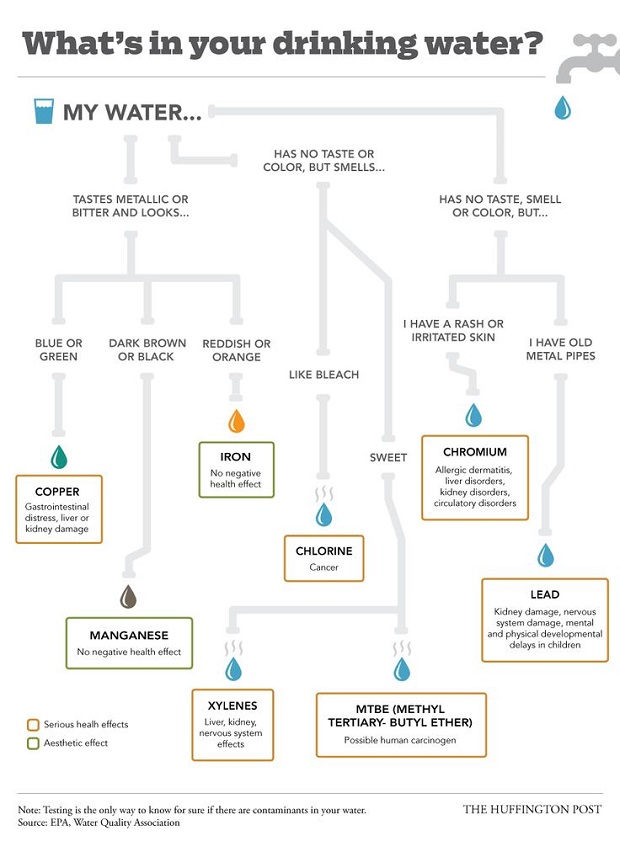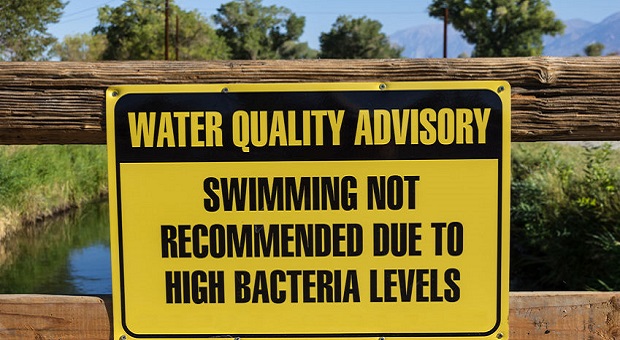We walk to the kitchen, turn on the tap and pour ourselves a big glass of that elixir of life: water. We assume because it has gone through the city water purification plant that it’s safe to drink. Before you take a swig, you need to know about the top killing agents that may be hidden in your drinking water!
There may also come a time when the worst has come to pass and you’re on the run for survival. You have come across a babbling brook that just beckons to you to quench your thirst. Though it may be perfectly safe to drink, if it’s not you can be in for a world of hurt. It’s imperative that you understand that just because the water LOOKS clean, you shouldn’t assume that it is.
Regardless of the water source, there’s always a chance that the water that you’re drinking is contaminated. There are many different ways that this can happen; in your home, it can be from outdated plumbing or antiquated water purification methods or equipment that don’t filter out modern-day contaminants such as pharmaceuticals and chemicals.
If you have a well then draught, flooding, mining activity or hydraulic fracking in the area can disrupt the water tables and contaminate your water.
Streams and other unpurified water sources can be polluted by chemicals, pesticides, antibiotics and fertilizers caused by runoff from nearby industrial plants or farms. They are also vulnerable to leaky sewage systems as well as animal defecation. Even acid rain and smog can pollute water.
Don’t worry though – today we’re going to tell you about the top pollutants and contaminants found in water so that you know what to test for. According to some sources, water contamination makes 2 million Americans sick every year and that number will increase exponentially if SHTF. You don’t want to be one of them, so in the next article in this series, we’ll tell you HOW to test for these pollutants.
Hexavalent Chromium, aka Chromium 6
Remember the Erin Brokovich story that took place in Hinckley, California back in 1996? The one where Pacific Gas and Electric (PG&E) had to pay out $333 million because they were killing people with chromium 6 that they were leaking? Well that problem hasn’t gone away.
A survey conducted by an Environmental Working Group showed that the drinking water in 31 out of 35 cities tested contained Chromium 6 in varying levels. The “safe” level set by the Office of Environmental health Hazard Assessment is 0.2ppb.
The highest levels were found in Norman, OK, Honolulu, HI and Riverside, CA. Cincinnati and Boston weren’t far behind. Hinckley, CA is actually having water shipped in because the Chromium 6 has leached through the clay barriers that were put in place by PG&E.
Chromium 6 causes cancer. Plain and simple. And it’s in the water supply of many cities across the US.
Fluoride
In 1946, Grand Rapids Michigan became the first US city to add fluoride to its water supply in an attempt to prevent tooth decay among its citizens. By 2008, more than 72% of Americans live in areas that add fluoride to the water supply.
Though the government shows studies that prove that tooth decay has declined significantly in populations that drink fluoride-supplemented water, the same decline has been noted in other countries that do not add fluoride. This is possibly due to better oral care, not the addition of fluoride.
Fluoride accumulates in bones and some people suspect that it plays a role in bone disorders as well as other health conditions. A review conducted by the National Academy of Science on the toxicity of fluoride concluded that it is an endocrine disruptor and may affect many different things in the body including the brain, bones, thyroid, pineal gland and possibly even blood sugar levels. According to those in the know, studies for links to dementia, ADHD, diabetes and other debilitating conditions need to be conducted.
Studies haven’t been adequately conducted to either prove or disprove these possibilities so in the meantime, you may wish to avoid fluoridated water. Here is a map that shows current cities with fluoridated water: Cities with fluoridated water as of March, 2015.
Arsenic
Arsenic is a naturally-occurring mineral. It may also cause cancer, birth defects, reproductive issues and serious skin problems. Oh, and it can kill you in high enough doses. According to a study conducted by the National Resource Defense Council, more than 22 million Americans are exposed to water that has average levels of 5ppb arsenic. In 2006, the EPA set a standard of 10ppb as safe but has since shown that there are no safe levels of arsenic.
Here is a link to a map showing groundwater levels of arsenic across the US: arsenic in groundwater.
Lead
There is no safe level of lead in the water even though the EPA has set the standard at no more than 15ppb. Water sanitation facilities are required to test for lead regularly and if this level is exceeded, action must be taken to reduce the levels.
Lead, which was used in paint until a few decades ago and is still present in many pipes and household fixtures such as brass doorknobs, is linked to delayed development, reduced attention span and learning disabilities in children. You can build toxic, lethal levels of lead with regular exposure. According to Healthline, symptoms include:
- Abdominal pain
- Abdominal cramps
- Aggressive behavior
- Constipation
- Sleep problems
- Headaches
- Irritability
- Loss of developmental skills in children
- Loss of appetite
- Fatigue
- High blood pressure
- Numbness or tingling in the extremities
- Memory loss
- Anemia
- Kidney dysfunction
Bacteria such as E. Coli, Salmonella, Campylobacter jejuni, Vibrio Cholerae and Staphylococcus Aureus
We all have bacteria in our bodies but it’s the good kind; the kind that helps to digest food and protect us from the bad kind. The bad kind of bacteria, including the ones listed above, wreak havoc on your body. E. Coli is found in human feces and is thus spread by contact with human feces, such as when water is contaminated with sewage.
Symptoms begin anywhere from a few hours to a few days after exposure and include diarrhea, stomach cramps, nausea, vomiting and fever. You may know this by the term “food poisoning” and if others are exposed to contaminated bodily fluids, it can be spread.
Campylobacter and salmonella are contracted from eating raw or undercooked poultry. Sometimes they’re associated with unpasteurized dairy products and produce, probably because of exposure to contaminated poultry. Water is contaminated by it either from exposure to these components (people dumping food in the water) or by farm runoff because chickens often carry the bacteria with no symptoms. Symptoms are the same as for e. coli.
Staphylococcus aureas is a different beast. It’s ugly and can kill you. It affects your skin, blood, heart and lungs and causes weeping, pus-filled abcesses. You can get the infection from contact with the bacteria to broken skin or you can get it from ingesting food or water tainted with it. Needless to say, it’s infectious but it can be treated with antibiotics.
Filtration with a filter .03 microns or smaller along with disinfection with chlorine, iodine or chlorine dioxide effectively kills bacteria.

Viruses Such as Hepatitis A, Rotavirus, Enterovirus and Norovirus
Hepatitis a is caused by ingesting food or water contaminated with feces. It’s also associated with undercooked shellfish. It affects the liver and symptoms include jaundice, nausea, vomiting, fever, diarrhea and abdominal pain and cramps.
Symptoms of Hepatitis A usually manifests 2-6 weeks after exposure and, though there is no treatment for it, it generally goes away on its own in about 8 weeks. Some people experience recurrence of the symptoms several months after the initial episode. It’s contagious.
Rotavirus is extremely common and is the most common cause of severe diarrhea in infants and small children. With each exposure, an immunity is built so it’s not as common in adults. Though it typically isn’t dangerous, nearly half a million kids, mostly in underdeveloped countries, die from it each year. Kids in the US are usually vaccinated for it. It can also infect livestock.
Non-Polio Enterovirus symptoms are usually similar to those of a cold: runny nose, fever, rash, mouth blisters and body aches. Some strains can cause hand, foot and mouth disease, viral meningitis and viral conjunctivitis (aka pink eye). In less common instances, it can cause infection in the brain, heart or the sack around the heart, or paralysis.
Enterovirus is spread by physical contact, touching contaminated surfaces and in water. Disinfectants such as chlorine, chlorine dioxide or iodine are effective against viruses.
Parasitic Protozoa, Such as Cryptosporidium and Giardia Lamblia, Amoebae, Ciliates, and Flagellates
Protozoa can survive for weeks or even months in cold water without a host. Both giardia (aka beaver fever) and crypto are in a protective shell called a cyst which makes it resistant to disinfectants including iodine and chlorine. Just a couple of tiny cysts can cause infection and once it hits your stomach, the acid eats through the cyst, releases the beast and the fun begins.
Infections from both cause watery diarrhea, stomach upset, vomiting, gas and intestinal distress. Infection lasts from 1-6 weeks typically but in people with weak immune systems, it can last up to a year. Boiling at a rolling boil for at least 1 minute kills it and filtering can help, too, if you use 1 micron or smaller filter.
Parasitic Worms Such as Flatworms, Flukes and Roundworms
Ok, this one is just gross to think about. They are actually worms that live and thrive in our bodies and are found in water. They’re spread from fecal matter that gets into water. You can get them from your pets, too. There are many types of worms including tapeworms, pinworms, hookworms, threadworms and heartworms and they can kill you if you don’t get rid of them; especially heartworms and tapeworms.
Flukes are confined to hot tropical areas such as North Africa and Southeast Asia but the rest of them are found pretty much everywhere.
Symptoms vary and include abdominal swelling, skin conditions, restlessness, anxiety (they affect your central nervous system), lethargy, constipation, diarrhea, gas, joint and muscle aches, and even food allergies because they affect your digestive tract.
In addition to being found in water, they’re also airborne in some instances, are transmitted via insects such as fleas and mosquitoes. They can be found in undercooked foods, on fruits and veggies and in the ground or in areas where fecal matter is or has been present.
The only way to get rid of worms is by using a medicine called an anthelmintic. Tapeworms are tougher to get rid of and don’t respond to some of the standard anthelmintics. Natural remedies include clove, black walnut and wormwood though the efficacy of these aren’t tested.
Treatment of water with chlorine, iodine or chlorine dioxide effectively kills most worms.
Chemicals and Pharmaceuticals
These sneak into your water because of pollution from farms, industrial communities and urban living. People dump unused drugs down the toilet and they’re also in urine and feces and make it into the water supply that way. Unfortunately, many water treatment plants are antiquated and not equipped to deal with the removal of these contaminants.
Many can be removed by distillation or reverse osmosis, though there are some chemicals that evaporate at a lower temperature than water so they pass through the still when you’re distilling the water. Reverse osmosis is the best way to filter these out.
As you can see, there are many pathogens and contaminants that can be present in water that can make you extremely ill. Streams in higher elevations that aren’t close to people are a safer bet but there’s no guarantee that there’s not a dead deer lying upstream or that infected animal feces isn’t in the water.
It’s always better to be safe than sick so treat every source of water as if it’s tainted when you’re in the wilderness. Regarding the safety of the water at your house, reverse osmosis systems that fit under the sink are great options and don’t cost too much. They’re also fairly easy to install so if you’re a bit handy, you’re good to go.
Do you have other concerns about water that we should know about? If so, tell us about them in the comments section below.
This article has been written by Theresa Crouse for Survivopedia.










Michael g murphy | May 18, 2015
|
Are you offering any type of water cleansing or purifier right now to help with the various bad things in our water? And if you are precisely how much are you charging for them?
Andrew wiggins | May 18, 2015
|
I use a Westinghouse water purifier for my home and a Westinghouse R/O at my sink. Theres a new program that alows the system to pay for itself . Do my budget never went up. Go to Westinghouseprogressive.com
Mahatma Muhjesbude | May 19, 2015
|
Well, that settles it once and for all.
I’m swearing off all water and restricting myself only to Beer,.
GoneWithTheWind | May 19, 2015
|
The Erin Brokovich story was a total fraud. A classic case of legal fiction and dumbed down jury. Zero evidence anyone was ever harmed in this instance but big bucks to Ms Brokovich and her lawyer employer.
Flouride is safe as it is used in the water supply. There are vast areas of the country that use flouride and considerable areas in the country that do not use flouride. Zero difference in illness or other health problems between these flouridated and non-flouridated water areas.
radarphos | June 11, 2015
|
You are greatly mistaken. You have not read recent research. Dr. Mercola of Mercola.com has addressed many problems with flouride in water all across the globe and cites references for the research results that he explains. Ultimately the greater reliability of information posted will be connected to research studies that are identified and trackable. In the last month (e.g., May 2015) Mercola.Com reported that the USA has adopted a lower standard for flouride in USA water, and why would that be??? Whenever a government agency that sets a lower standard on the parts per million or billion allowable in water, the reason is always a liability risk and based in research that is considered valid and reliable. Even though flouride is found in some parts of the country as “naturally occuring”, that does not mean that it is healthy for anyone.
Andrew wiggins | June 11, 2015
|
This guy is crazy. Fluoride is extremely hazardous. If you don’t think so drink a glass of it. See what happens. I know if it’s diluted in water it’s okay. Yea keep telling yourself that.
Pingback:How To Test Your Water For Pollution Agents | Survival skills, survival guns, survival guide | May 20, 2015
|
Fred Roehl | May 20, 2015
|
Would like to know more information on how to filter the hole house. Due to I am living on well water out in the country.
Pingback:How To Choose A Water Filter | Survival skills, survival guns, survival guide | May 29, 2015
|
Pingback:How To Choose Your Water Filterdisasterdefense.us | disasterdefense.us | May 30, 2015
|
Pingback:6 Natural Contaminants Found In Water | Survival skills, survival guns, survival guide | June 11, 2015
|
Pingback:6 Natural Contaminants Found In Waterdisasterdefense.usdisasterdefense.us | disasterdefense.us | June 11, 2015
|
radarphos | June 11, 2015
|
Glen Meder, producer of a portable distiller grew up in a water distillation family (e.g., his father manufactuers commercial distillers). He says about his product (that I have bought and used) that you are correct that some chemicals in water do evaporate at temperatures less than the boiling point; and as a result he recommends that a person not begin collecting distilled water until the water is in an active boil. The distiller I bought won’t even give me a drop of condensed water until the water is rapidly boiling. But Meder’s water distiller is built so that it does not begin collecting evaporated water until the water from the boiling pot is rapidly boiling. So, my point here is that when you speak in general about water distillation, that is fine…you are raising a valid matter; but your valid matter may also be remediated depending upon what products various people may own.
Glen Meder also reports that water distillation will remove radioactive cesium from water; and as a result of that it is believed that the likelihood exists that only water distillation will remove nuclear fallout (such as from Fukishima that is still to this day (June 2015) burning away sending nuclear fallout all across America and beyond. I trust Glen Meder because he grew up in a commercial water distillation business family, and has access to his father and others in the family business, and he has manufactured a portable “survival distiller” that can take ocean water, distill it, and produce drinkable water.
Pingback:City vs. Rural Bug In: How Do You Handle Your Reserves? - Survival By Preparedness | December 2, 2015
|
Pingback:Hidden Toxins In Everyday Life That Are Slowly Killing You | Survivopedia | September 11, 2016
|
Pingback:Killing Us Softly – How Just Breathing Is Deadly | Survivopedia | October 17, 2016
|
Pingback:How To Choose A Water Filter | Survivopedia | November 19, 2018
|
Pingback:6 Natural Contaminants Found In Water | Survivopedia | December 3, 2019
|